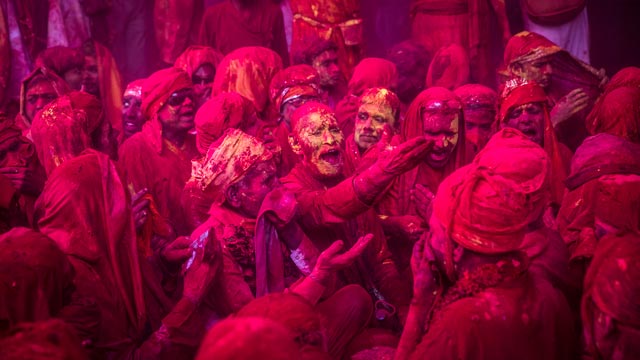Holi is the Indian Festival of Colors. It’s celebrated on the full moon. Holi falls in late March to early April in the western calendar. In 2015, it’s March 23. Holi is also called Phalgun Purnima or Pooranmash. It comes in the Hindu calendar month of Phalgun. Indians celebrate by tossing colored powder or spraying each other with colored liquid. Here are free printable Holi crafts, greeting cards and worksheets to help kids understand Holi. Teachers, use these for social studies. Home school parents, why not explore Holi with kids?
Colors of Holi
Holi celebrants can chose from natural colors such as tumeric, haldi, flower extracts, sandalwood and mehndi. These are cheap and can be prepared at home. Street vendors make it easy to be colorful and do a brisk business from their push carts. The use of colorful chemicals is discouraged for they can damage both the skin and the environment.
In India, Holi announces the arrival of spring and the passing of winter. The festival breathes an atmosphere of social merriment. People bury their hatchets with a warm embrace and throw their worries to the wind. Every nook and corner presents a colorful sight. Young and old alike are covered with colors (red, green, yellow, blue, black and silver). People in small groups are seen singing, dancing and throwing colors on each other. Though liquid colors are used in India (where it’s warm) we prohibit them, as we don’t want anyone to catch cold on account of the festival. Dry is better for photographs as well.
Modern Adaptation
Holi has long traditional links with several legends. According to one popular legend, the word Holi is derived from the demoness, Holika. She was the sister of Hiranya Kashipu (the name meaning love of gold and a soft bed), a demon king, who having defeated the gods, proclaimed his supremacy over everyone else in the Universe. Enraged over his son’s ardent devotion to Lord Vishnu, Hiranya Kashipu decides to punish him. He takes the help of his sister, Holika, who is immune to any damage from fire. Holika carries the small boy Prahlad into the fire but a divine intervention destroys her and saves Prahlad from getting burned. Thus Holi is celebrated to mark the burning of the evil Holika. Her effigy is consumed in the fire!
Holi is celebrated with special importance in the North of India. It solemnizes the love of Radha and Krishna. The spraying of colored powders recalls the love sport of Lord Krishna and His devotees.
The color, noise and entertainment that accompanies the celebration of Holi bears witness to a feeling of oneness and sense of brotherhood. The festival brings home the lesson of spiritual and social harmony!!
Author is a professional content writer who has worked for over 50 brands across the globe. She has sound knowledge on festivals which are celebrated in India. She has written and published content on more than 30 festivals. In this article she has discussed about holi celebration. She has shared some ideas on how to celebrate holi.
Check our india budget tour
Check our india travel
Check india tour operator
Check india tour planner
